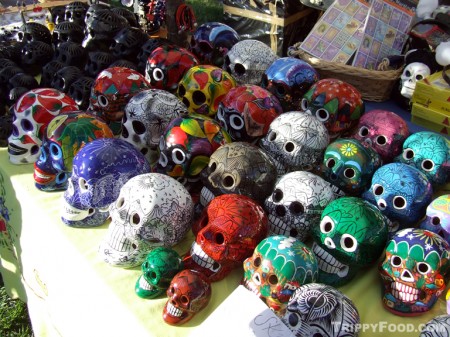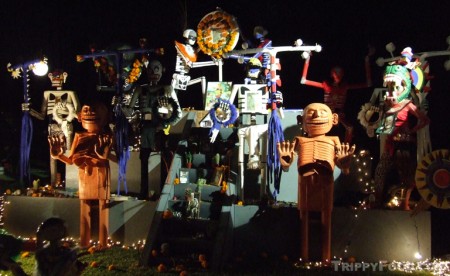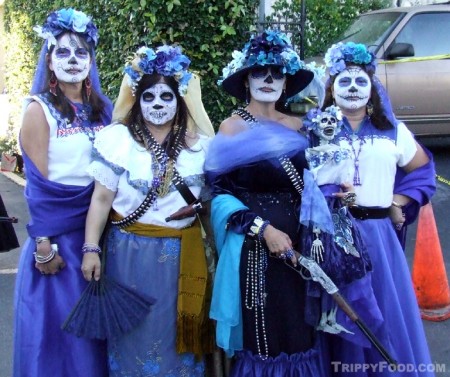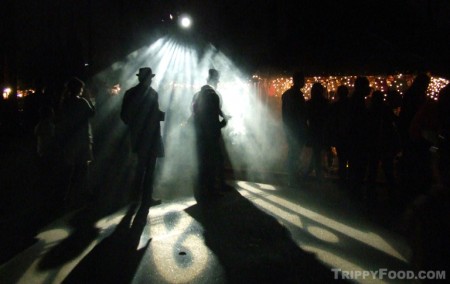Dia de los Muertos (Day of the Dead)
Mexico/Southwestern U.S.
What do New Orleans Jazz Funerals, Irish wakes and Dia de los Muertos have in common? All are celebrations of life and a way to either send someone off in style or reach out to loved ones in the afterlife. The modern day Dia de los Muertos is derivative of an Aztec festival to the Mictecacihuatl, goddess (or lady) of the dead. The celebration was held in the ninth month of the Aztec calendar (roughly corresponding to August) and celebrated for a month; the festival included presentations of orange Mexican marigolds called cempoalxochitl (which translates from Nahuatl to “twenty flowers”). The flowers are now referred to as flor de fuerto, or flower of the dead and are used to attract the souls of the dead. During Mexico’s Christian era, Mictecacihuatl has been replaced by the Virgin of Guadeloupe, but is also sometimes represented by the Catrina, an animated female skeleton figure usually dressed in fancy clothing. The timing of the event also changed after the Spanish Christianization to coincide with the Catholic holidays of All Saints’ Day (November 1st) and All Souls’ Day (November 2nd). Typically Dia de los Inocentes (“Day of the Innocents”) falls on November 1st and commemorates the passing of children, with Dia de los Muertos (“Day of the Dead”) honoring adults on November 2nd. Participants dress in costumes representing historical figures or loved ones (often as skeletons) or as the Catrina; because of this custom and the fact that the festivals occur the day after Halloween, they are often assumed to be culturally the same.
During Dia de los Muertos, families create altars and displays called ofrendas at the gravesite. These usually feature a profusion of the flor de fuerto, pictures of the deceased and things that they would have enjoyed while alive (such as their favorite foods, toys, possessions, or objects representing their passions and professions). Family members eat at the gravesite, and partake of some of the food presented as nourishment for those who have shuffled off this mortal coil, including ridiculously large loaves of pan de muerto (bread of the dead) and skulls made of sugar. In recent times, children dress as skeletons and go door-to-door asking for little sugar skulls, candy or money, an adaptation of Halloween trick-or-treating. Although Dia de los Muertos has traditionally been a family ritual, it has become popularized to where people of no relation to the deceased flock to cemeteries to participate in an all-night party designed to wake the dead. Nowhere is this more obvious than at the annual celebration at Hollywood California’s Hollywood Forever Cemetery, an event that has been held since 1999. The fact that Hollywood Forever is the final resting spot for more deceased film industry folks per square foot that anywhere else in Southern Califorina makes the event even more spectacular; it is the last stop on this train called life for Mel Blanc, Douglas Fairbanks, Jr., Cecil B. DeMille, Rudolph Valentino and countless others. The event starts at 2 PM, and as soon as you enter the front gates you realize this is going to be a celebration of epic proportions. Dancers in Aztec costumes rove the grounds performing in the wider intersections; a central stage is set up that features bands and performers throughout the day. To the left of the stage and wrapping around behind it are dozens of food tents representing a variety of vendors; Oaxacan restaurant Guelaguetza did a brisk business selling cerveza, taquitos and outstanding tamal de mole Oaxaqueno wrapped in banana leaves and drenched in sweet black mole. La Monarca Bakery was handing out free samples of the sweet pan de muerto, billing themselves as purveyors of the Official Day of The Dead Bread (one can surmise that this is the bread Elvis now uses to make his peanut butter and banana sandwiches). Naturally, the bacon-wrapped hot dog (soon to be named the Official Hot Dog of Los Angeles) was available in mass quantities; they were easy to find simply by listening for the melodic, “Hooooooot dog, hot dog hot dog hot dog).
The ofrendas were mixed with commercial ventures selling everything from ceramic skulls to attire designed to help you leave behind a pretty corpse. One tent offered bandannas with skull faces imprinted on them so you’ll never need to have your face painted like Alton Kelley’s Grateful Dead album cover again (although face painting was available in several tents). Art was available for display and purchase; in the mausoleum where Rudolph Valentino is interred (guarded by two gargantuan Mexican skeletons), art lined the walls, obscuring the names of those trying to rest in their vaults. Rest would have been difficult since in addition to the patrons cramming through the hallways to see the works of art, a band was stationed inside near the exit, their music reverberating against the marble walls. The ofrendas were spectacular enough during the day, but as night fell and candles were lit and the lights went on, they took on new life. The gravesites of Dee Dee and Johnny Ramone were decked out and roped off, and it wasn’t difficult to imagine that they were both doing an upbeat rendition of “Pet Sematary”. Along the long avenues that stretched to the entrance were the ofrendas of family members who spared no expense in staging elaborate displays; it was sobering when you realized that these people actually lost loved ones, but heartwarming that they kept their spirits alive with a smile and were even willing to discuss how they came to end up on the other side.
If you decide to attend the event, be sure to get there early as the line snakes out to the sidewalk as the night progresses; the event lasts until midnight. I don’t recall a great deal of the film version of Stephen King’s “Pet Sematary”, but I like to imagine that when Fred Gwynn (also our beloved Halloween icon Herman Munster) uttered the words, “Sometimes dead is better”, it was in response to the question of which he preferred: Halloween or Dia de los Muertos.
Hollywood Forever
6000 Santa Monica Blvd
Los Angeles, CA 90038
GPS Coordinates: 34°5’25.18″N 118°19’12.41″W





